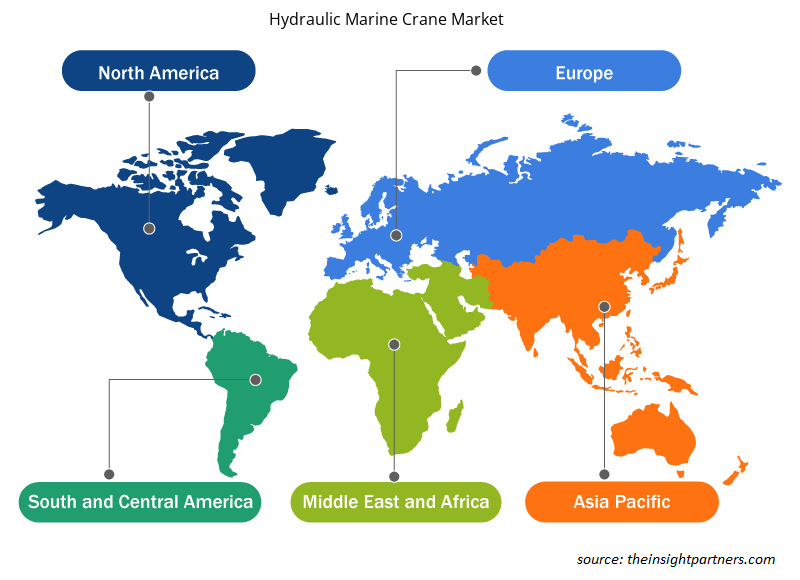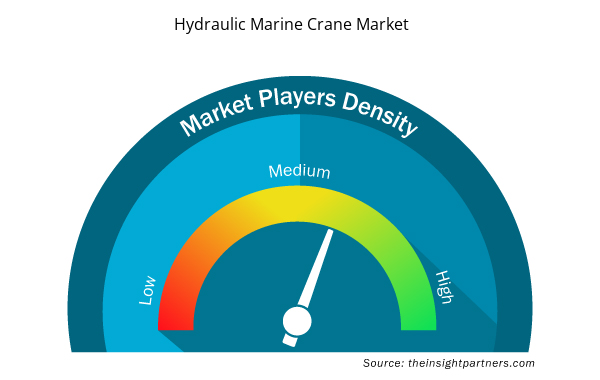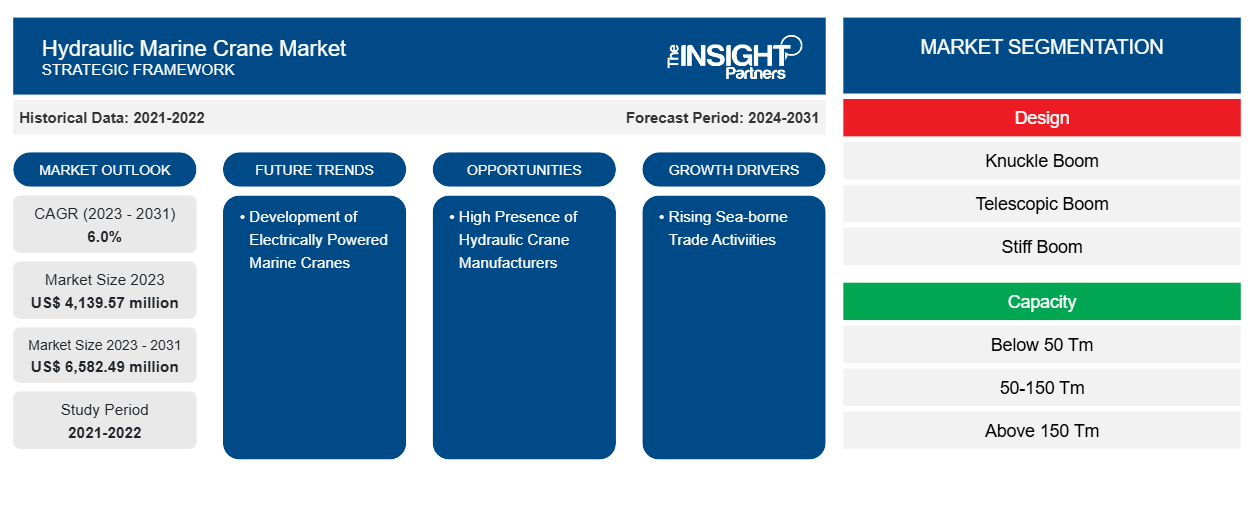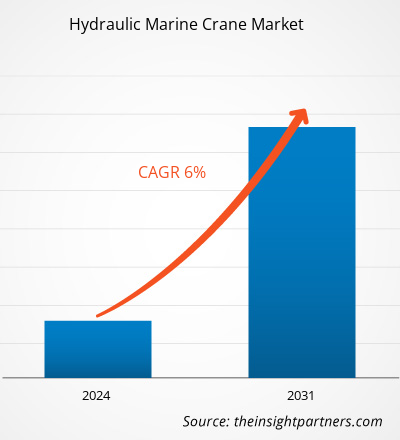预计到 2031 年,液压船用起重机市场规模将从 2023 年的 41.3957 亿美元增至 65.8249 亿美元。预计 2023-2031 年期间市场复合年增长率将达到 6.0%。海上贸易活动的增多和政府对海洋基础设施发展的日益重视可能仍将是市场的主要趋势。
液压船用起重机市场分析
政府对海洋基础设施建设的多项投资增加了对液压船用起重机市场的需求。大量的船舶制造商将直接导致全球对液压船用起重机的需求增加。北美和欧洲等发达地区拥有顶级船用起重机制造商,如 DMW Marine Group 和 Fred Wahl Marine Construction, Inc.,它们提供折臂式、伸缩臂式和硬臂式船用起重机。这些都将增加液压船用起重机市场的增长。
液压船用起重机市场概况
技术的不断发展使工人能够保持敏捷。船舶和海上项目的先进技术的整合将推动全球液压船用起重机市场的增长。沙特阿拉伯等国家正在采购海上运输船队,这将加强先进技术在多艘船舶(如货船和海军舰艇等)中的部署。为了实施和建设新的技术基础设施,需要船用起重机,这推动了对液压船用起重机的需求。
定制此报告以满足您的需求
您可以免费定制任何报告,包括本报告的部分内容、国家级分析、Excel 数据包,以及为初创企业和大学提供优惠和折扣
- 获取此报告的关键市场趋势。这个免费样品将包括数据分析,从市场趋势到估计和预测。
液压船用起重机市场驱动因素和机遇
海上贸易活动增多利好市场
政府的政策和法规有利于国际贸易活动,吸引了外国投资。此外,一些政府专注于发展海洋产业并吸引该领域的外国直接投资,这增加了海上贸易活动并对液压起重机市场产生了积极影响。港口和船舶建造中不断增加的技术开发项目对贸易活动产生了积极影响。越来越多的海上贸易活动需要适当的港口基础设施和码头设施来满足大量商船的需求,这是全球液压起重机市场的主要驱动力。
液压起重机制造商的存在感很强
与其他地区相比,欧洲、亚太地区和北美等地区的船用起重机制造商数量较多。意大利、中国和美国是拥有最大船用起重机制造商的国家之一。这些地区提供的船用起重机类型包括折臂式、伸缩臂式和刚性臂式船用起重机。因此,随着船用起重机制造商数量的增加,市场预计将实现正增长。美国还有大量的船舶制造商,这将直接导致对液压船用起重机的需求增加。
液压船用起重机市场报告细分分析
有助于得出液压船用起重机市场分析的关键部分是设计、容量和吊臂长度。
- 根据设计,液压船用起重机市场分为折臂式起重臂、伸缩式起重臂、刚性起重臂和可折叠式起重臂。 2023 年,可折叠式起重臂部分占据了较大的市场份额。
- 根据产能,市场分为 50 Tm 以下、50-150 Tm 和 150 Tm 以上。2023 年,50 - 150 Tm 部分占据了相当大的市场份额。
- 根据吊杆长度,市场分为 10 米以下、10-20 米和 20 米以上。2023 年,10 米以下部分占据了相当大的市场份额。
液压船用起重机市场份额(按地区)分析
液压船用起重机市场报告的地理范围主要分为五个区域:北美、亚太、欧洲、中东和非洲、南美和中美。
欧洲是市场领导者。政府对海洋基础设施开发的大量投资对该地区液压船用起重机市场的需求产生了积极影响。港口和船舶制造领域的技术开发项目不断增加,增加了欧洲市场对液压船用起重机的需求。欧洲是一个经济发达的地区。英国、西班牙、意大利、法国、德国、瑞士、俄罗斯、瑞典和荷兰是该地区的一些主要国家。造船和液压起重机制造商的大量存在也对欧洲液压船用起重机市场产生了积极影响。
液压船用起重机市场区域洞察
Insight Partners 的分析师已详细解释了预测期内影响液压船用起重机市场的区域趋势和因素。本节还讨论了北美、欧洲、亚太地区、中东和非洲以及南美和中美洲的液压船用起重机市场细分和地理位置。

- 获取液压船用起重机市场的区域具体数据
液压船用起重机市场报告范围
| 报告属性 | 细节 |
|---|---|
| 2023 年的市场规模 | 41.3957亿美元 |
| 2031 年市场规模 | 65.8249亿美元 |
| 全球复合年增长率(2023 - 2031) | 6.0% |
| 史料 | 2021-2022 |
| 预测期 | 2024-2031 |
| 涵盖的领域 | 通过设计
|
| 覆盖地区和国家 | 北美
|
| 市场领导者和主要公司简介 |
|
市场参与者密度:了解其对商业动态的影响
液压船用起重机市场正在快速增长,这得益于终端用户需求的不断增长,而这些需求又源于消费者偏好的不断变化、技术进步以及对产品优势的认识不断提高等因素。随着需求的增加,企业正在扩大其产品范围,进行创新以满足消费者的需求,并利用新兴趋势,从而进一步推动市场增长。
市场参与者密度是指在特定市场或行业内运营的企业或公司的分布情况。它表明在给定市场空间中,相对于其规模或总市场价值,有多少竞争对手(市场参与者)存在。
在液压船用起重机市场运营的主要公司有:
- Amco Veba 船舶
- DMW海事集团
- 法西集团
- 弗雷德沃尔海洋建筑有限公司
- 海拉起重机有限公司
- 液压工业公司
免责声明:上面列出的公司没有按照任何特定顺序排列。

- 了解液压船用起重机市场主要参与者概况
液压船用起重机市场新闻和最新发展
通过收集一手和二手研究后的定性和定量数据来评估液压船用起重机市场,其中包括重要的公司出版物、协会数据和数据库。液压船用起重机市场的一些发展情况如下:
- Amco Veba Marine 推出了 40tm 船用起重机。(来源:Amco Veba Marine,新闻稿,2022 年 5 月)
- Amco Veba Marine 的 V820NM 和 V823NMcrane 类别已通过 DNV 认证,符合船用起重设备标准 DNV-ST-0377。(来源:Amco Veba Marine,新闻稿,2022 年 9 月)
液压船用起重机市场报告覆盖范围和交付成果
“液压船用起重机市场规模和预测(2021-2031 年)”报告对以下领域进行了详细的市场分析:
- 范围内涵盖的所有主要细分市场的全球、区域和国家层面的液压船用起重机市场规模和预测
- 液压船用起重机市场趋势以及市场动态,如驱动因素、限制因素和关键机遇
- 详细的 PEST 和 SWOT 分析
- 液压船用起重机市场分析涵盖主要市场趋势、全球和区域框架、主要参与者、法规和最新市场发展
- 行业格局和竞争分析,涵盖市场集中度、热点图分析、知名企业以及液压船用起重机市场的最新发展
- 详细的公司简介
- 历史分析(2 年)、基准年、预测(7 年)及复合年增长率
- PEST 和 SWOT 分析
- 市场规模价值/数量 - 全球、区域、国家
- 行业和竞争格局
- Excel 数据集


- Mail Order Pharmacy Market
- Sterilization Services Market
- Vertical Farming Crops Market
- Legal Case Management Software Market
- Europe Tortilla Market
- Predictive Maintenance Market
- Real-Time Location Systems Market
- Single Pair Ethernet Market
- Smart Water Metering Market
- Energy Recovery Ventilator Market

Report Coverage
Revenue forecast, Company Analysis, Industry landscape, Growth factors, and Trends

Segment Covered
This text is related
to segments covered.

Regional Scope
North America, Europe, Asia Pacific, Middle East & Africa, South & Central America

Country Scope
This text is related
to country scope.
常见问题
Europe dominated the hydraulic marine crane market in 2023.
The development of electrically powered marine cranes is the future trend of the hydraulic marine crane market.
Amco Veba Marine, DMW Marine Group, Fassi Gru S.p.A., Fred Wahl Marine Construction, Inc., Heila Cranes S.p.A., Hydrauliska Industri AB, HS.MARINE S.r.L., HYVA, Industrias Guerra, S.A., Kenz Figee, Melcal, Mkg Maschinen-& Kranvertrieb, and Palfinger AB are some of the leading players in the market.
US$ 6,582.49 million estimated value of the hydraulic marine crane market by 2031.
6.0% is the expected CAGR of the hydraulic marine crane market.
Trends and growth analysis reports related to Manufacturing and Construction : READ MORE..
The Insight Partners performs research in 4 major stages: Data Collection & Secondary Research, Primary Research, Data Analysis and Data Triangulation & Final Review.
- Data Collection and Secondary Research:
As a market research and consulting firm operating from a decade, we have published and advised several client across the globe. First step for any study will start with an assessment of currently available data and insights from existing reports. Further, historical and current market information is collected from Investor Presentations, Annual Reports, SEC Filings, etc., and other information related to company’s performance and market positioning are gathered from Paid Databases (Factiva, Hoovers, and Reuters) and various other publications available in public domain.
Several associations trade associates, technical forums, institutes, societies and organization are accessed to gain technical as well as market related insights through their publications such as research papers, blogs and press releases related to the studies are referred to get cues about the market. Further, white papers, journals, magazines, and other news articles published in last 3 years are scrutinized and analyzed to understand the current market trends.
- Primary Research:
The primarily interview analysis comprise of data obtained from industry participants interview and answers to survey questions gathered by in-house primary team.
For primary research, interviews are conducted with industry experts/CEOs/Marketing Managers/VPs/Subject Matter Experts from both demand and supply side to get a 360-degree view of the market. The primary team conducts several interviews based on the complexity of the markets to understand the various market trends and dynamics which makes research more credible and precise.
A typical research interview fulfils the following functions:
- Provides first-hand information on the market size, market trends, growth trends, competitive landscape, and outlook
- Validates and strengthens in-house secondary research findings
- Develops the analysis team’s expertise and market understanding
Primary research involves email interactions and telephone interviews for each market, category, segment, and sub-segment across geographies. The participants who typically take part in such a process include, but are not limited to:
- Industry participants: VPs, business development managers, market intelligence managers and national sales managers
- Outside experts: Valuation experts, research analysts and key opinion leaders specializing in the electronics and semiconductor industry.
Below is the breakup of our primary respondents by company, designation, and region:

Once we receive the confirmation from primary research sources or primary respondents, we finalize the base year market estimation and forecast the data as per the macroeconomic and microeconomic factors assessed during data collection.
- Data Analysis:
Once data is validated through both secondary as well as primary respondents, we finalize the market estimations by hypothesis formulation and factor analysis at regional and country level.
- Macro-Economic Factor Analysis:
We analyse macroeconomic indicators such the gross domestic product (GDP), increase in the demand for goods and services across industries, technological advancement, regional economic growth, governmental policies, the influence of COVID-19, PEST analysis, and other aspects. This analysis aids in setting benchmarks for various nations/regions and approximating market splits. Additionally, the general trend of the aforementioned components aid in determining the market's development possibilities.
- Country Level Data:
Various factors that are especially aligned to the country are taken into account to determine the market size for a certain area and country, including the presence of vendors, such as headquarters and offices, the country's GDP, demand patterns, and industry growth. To comprehend the market dynamics for the nation, a number of growth variables, inhibitors, application areas, and current market trends are researched. The aforementioned elements aid in determining the country's overall market's growth potential.
- Company Profile:
The “Table of Contents” is formulated by listing and analyzing more than 25 - 30 companies operating in the market ecosystem across geographies. However, we profile only 10 companies as a standard practice in our syndicate reports. These 10 companies comprise leading, emerging, and regional players. Nonetheless, our analysis is not restricted to the 10 listed companies, we also analyze other companies present in the market to develop a holistic view and understand the prevailing trends. The “Company Profiles” section in the report covers key facts, business description, products & services, financial information, SWOT analysis, and key developments. The financial information presented is extracted from the annual reports and official documents of the publicly listed companies. Upon collecting the information for the sections of respective companies, we verify them via various primary sources and then compile the data in respective company profiles. The company level information helps us in deriving the base number as well as in forecasting the market size.
- Developing Base Number:
Aggregation of sales statistics (2020-2022) and macro-economic factor, and other secondary and primary research insights are utilized to arrive at base number and related market shares for 2022. The data gaps are identified in this step and relevant market data is analyzed, collected from paid primary interviews or databases. On finalizing the base year market size, forecasts are developed on the basis of macro-economic, industry and market growth factors and company level analysis.
- Data Triangulation and Final Review:
The market findings and base year market size calculations are validated from supply as well as demand side. Demand side validations are based on macro-economic factor analysis and benchmarks for respective regions and countries. In case of supply side validations, revenues of major companies are estimated (in case not available) based on industry benchmark, approximate number of employees, product portfolio, and primary interviews revenues are gathered. Further revenue from target product/service segment is assessed to avoid overshooting of market statistics. In case of heavy deviations between supply and demand side values, all thes steps are repeated to achieve synchronization.
We follow an iterative model, wherein we share our research findings with Subject Matter Experts (SME’s) and Key Opinion Leaders (KOLs) until consensus view of the market is not formulated – this model negates any drastic deviation in the opinions of experts. Only validated and universally acceptable research findings are quoted in our reports.
We have important check points that we use to validate our research findings – which we call – data triangulation, where we validate the information, we generate from secondary sources with primary interviews and then we re-validate with our internal data bases and Subject matter experts. This comprehensive model enables us to deliver high quality, reliable data in shortest possible time.


 获取此报告的免费样本
获取此报告的免费样本